Erstwhile columnist Fred Van Lente is back to celebrate the King’s birthday!
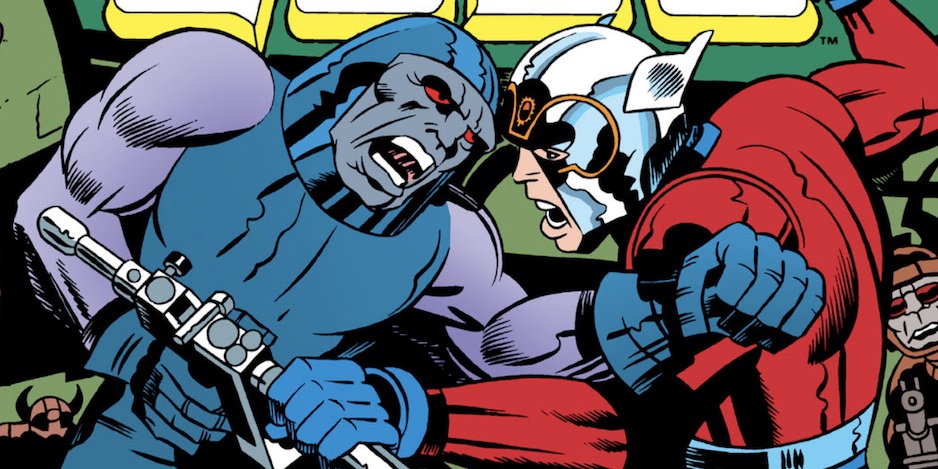
By FRED VAN LENTE
Heigh-ho, classic comics lovers! Fred Van Lente here, professional writer and amateur historian, back on Jack Kirby’s birthday — he was born Aug. 28, 1917 — to celebrate another segment of the endlessly fertile career of my favorite comics creator and, statistically speaking, yours.
I’ve been moving backward through the King’s career, starting with his swan song in mainstream comics at ’70s Marvel, then his final creations at DC, which means that in 2022 I am tackling what many believe to be his masterpiece — the trilogy of cosmic hero books he created (along with bringing pre-existing title Jimmy Olsen into that same fold) for Marvel’s Distinguished Competition after becoming finally fed up with his boss and co-creator, Stan Lee.
I own the four hardcover volumes DC put out around 2007 — Jack Kirby’s Fourth World Omnibus — and originally it seemed odd to me to run the quartet of titles in publication order, rather than group each title individually in numerical order. I have finally come around to see the wisdom of this. These comics are meant to be read episodically, off the newsstand, with a few weeks’ interval in between, and can be overwhelming if you try to read them in large, novel-length chunks.

For one thing, Kirby just begins firehosing you with concepts and does not let up. You are barely beginning to keep all the members of the Forever People straight when Sonny Sumo turns up. We barely have time to get used to Mister Miracle as a super-escape artist when Big Barda arrives via Boom Tube and basically steals the show from her future husband.
I love these comics, but, as the kids say, they are a lot.
I’ve been doing these lists for 13th Dimension for a couple years now, and I’ve got to say I struggled with this one the most. Legendary misfires such as Goody Rickles and the Forever People’s crossover with Deadman are easily excluded, but there are so many good issues during this run it was hard to whittle it down to a baker’s dozen — well-regarded classics like “The Death-Song of the Terrible Turpin,” “The Black Racer” and “The X-Pit” found themselves on the cutting room floor.
That said, I’m proud of the results. Here they are, JACK KIRBY’s TOP 13 FOURTH WORLD ISSUES — RANKED:
—
13. New Gods (Vol. 2) #6: Even Gods Must Die! I’ll direct folks to John Morrow’s excellent Old Gods & New for an exhaustive skinny on the Fourth World saga off the comics page, but suffice it to say after their unceremonious cancellation, Kirby’s relationship with his creation was a real roller-coaster for the rest of his life. Annoyed at Darkseid being treated like the village bicycle by all sorts of creators who weren’t him—fighting the X-Men in the greatest DC/Marvel crossover and trying to shotgun marry Wonder Woman on Saturday mornings—he was inclined to have Darkseid and his son Orion kill each other in a massive drag-out fight as prophesied.
On the other hand, his New Gods were now toys, generating income for his family, so Kirby was hesitant to kill them off. So for the cover of this glossy (partly) reprint issue to declare this is the “Conclusion” of the New Gods saga is both literally and spiritually inaccurate — it is, however, the last great complete Kirby story.
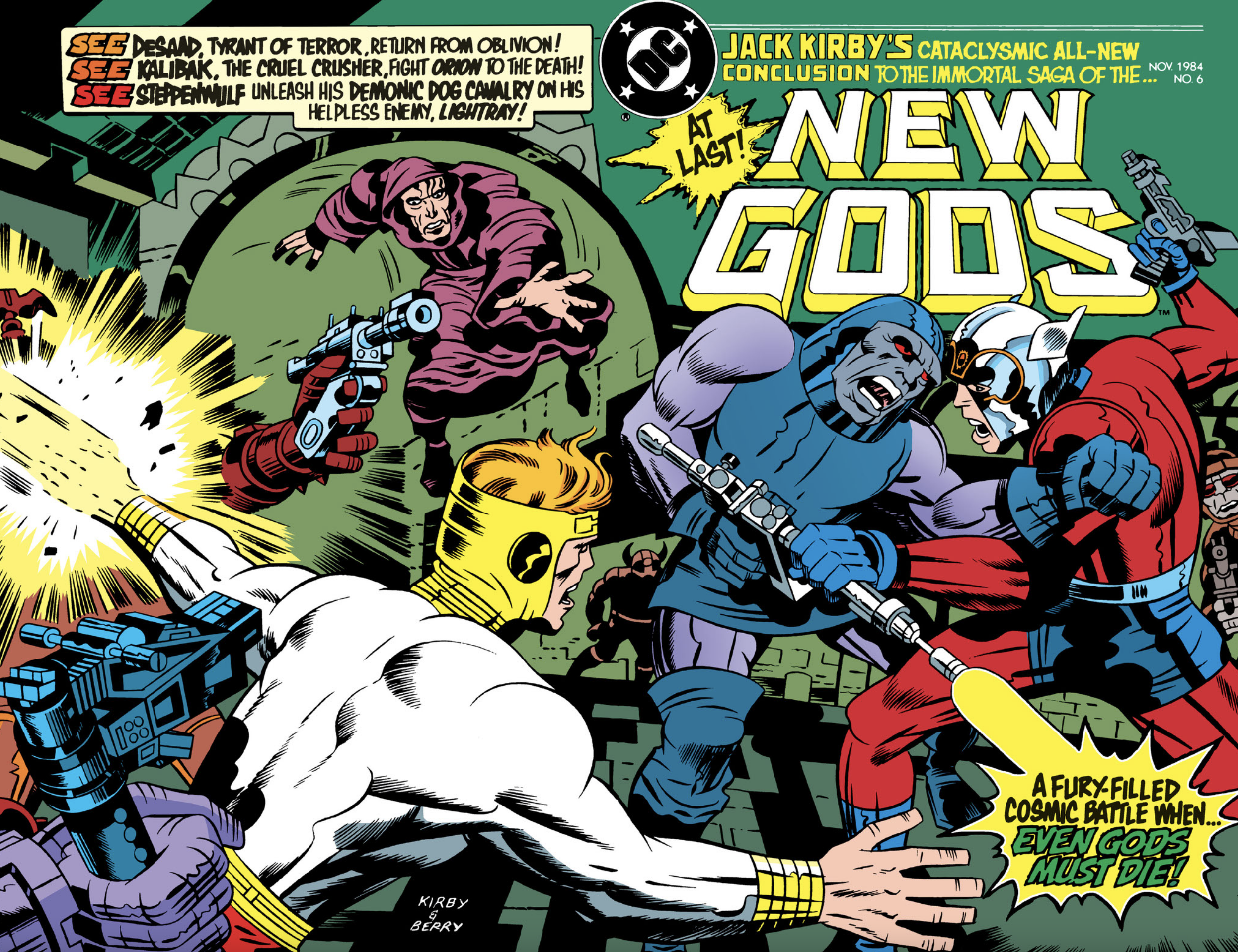
Orion attacks a newly mechanized- and computerized-Apokolips that seems to frighten even Darkseid. He’s so freaked out that he brings the recently vaporized DeSaad back to life to keep him company, in a truly unsettling nine-panel grid that proves that even this late in his career Kirby is still the master of his craft. (Darkseid resurrects Steppenwolf too, so I guess Zack Snyder read this story?)
The ferocity of Orion’s final assault on Darkseid’s fortress is the Kirbiest of all possible Kirbys, and seems to result in our hero’s gruesome demise — but even Darkseid won’t believe it unless he finds a body. (“If Orion is dead… he’s left behind him eternal fear!”) This is a lead-in to the unjustly maligned true “finish” to Kirby’s saga, the graphic novel Hunger Dogs, but I like the set-up better.
—
12. Superman’s Pal Jimmy Olsen #134: The Mountain of Judgment! So, like, Jimmy and the Newsboy Legion have been sent in their groovy War Wagon to The Wild Area, which is, like, this natural preserve for people who want to drop in and tune out, man. Clark Kent, no dummy, suspects that Morgan Edge, the new owner of the Daily Planet is, like, totally Traitorsville for sending Jimmy on this mission, so Superman busts in and makes a scene.
But, like, Jimmy can take care of himself, man, and defeated the leader of this motorcycle gang, the Outsiders, who are trying to find the legendary Mountain of Judgment, and so they got to go through, like, a brain-melting Kirby Collage road rally of psychedelic landscapes to reach it.
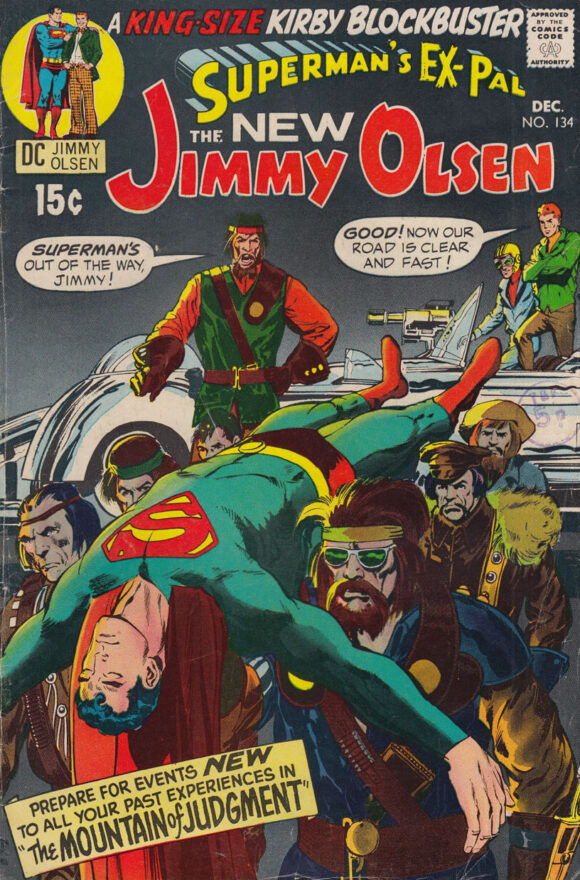
What’s totally, like, amazing though, is that the “mountain” turns out to be a giant 12-wheeled missile carrier guarding a top-secret government cloning project. That square Edge, man, he’s loaded the Newsboys Legion’s TV camera with a bomb but Superman totally duds it, saving the day.
Oh, and this issue’s got the first appearance of Morgan Edge’s boss, that Darkseid cat, too.
Far out, man.
—
11. Mister Miracle #3: The Paranoid Pill! Doctor Bedlam turns an entire apartment building into a mass of raving lunatics and faster than you can say 28 Days Later, they are all running after and trying to murder one man, the one person to ever escape the clutches of Apokolipis, Scott Free, Mr. Miracle. I don’t have much to say about this other than the last eight pages of this comic are one of the best action sequences in the Kirby oeuvre, anticipating the Me-vs.-the Building slugfests of The Raid and Dredd.
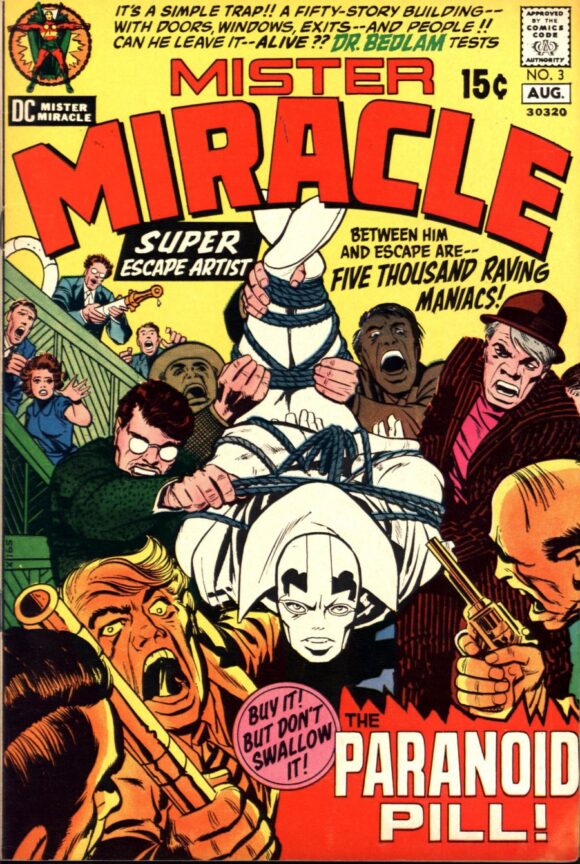
—
10. Mister Miracle #9: Himon! Planned for later in the series, the story of how diehard Apokolips aero-trooper Scott Free gets lured to the light side of the Source by the Fagin-esque Himon, got bumped up earlier in the run once Kirby found out the Fourth World as a franchise (if not the Mister Miracle title itself) was about to get the ax.
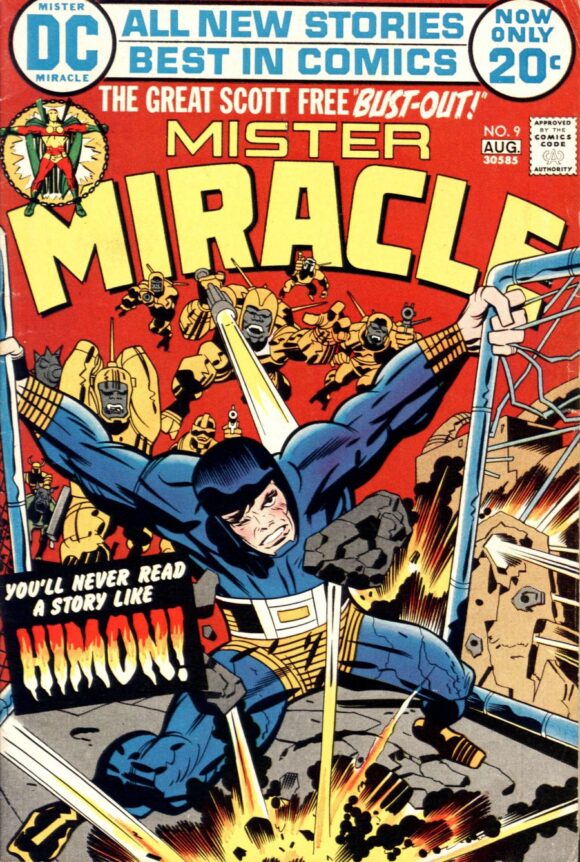
I’ve long thought that an entire series based on the “Young Scott Free” stories was easy money for DC. I love the Orwellian touch that Darkseid may not exactly be trying his hardest to capture Himon, as the elderly rebel’s presence on Apokolips as a boogeymen benefits his own regime. The meet-cute between Barda and Scott when they were kids is pretty terrific; Kirby can write future-lovers-start-by-hating-each-other with the best of them. And for all the criticism Kirby gets on his dialogue (much of it wholly justified—for some reason all the Fourth World’s Earthling characters have to announce their full names and occupations in their first line of dialogue in every issue, which, let me tell you, gets real old real fast), the immortal line “Let me be Scott Free — and find myself!” earns this ish a spot on this list.
—
9. The Forever People #8: The Power! Fascinatingly, in a Freudian sort of way, Kirby puts the most innocent of his Fourth World heroes into the grimmest and most nihilistic of scenarios. Vykin & Co. encounter another person with the Anti-Life Equation, but unlike the inherently noble Sonny Sumo, Billion-Dollar Bates is a petty narcissist who uses his ultimate mind-control powers to set himself up as the warlord of a small city somewhere in the USA. Unfortunately, for Bates, denizens of Apokolips have infiltrated his sect under cover of an invasion by the Forever People, leading to an unforgettable confrontation between our youthful protagonists and Darkseid.
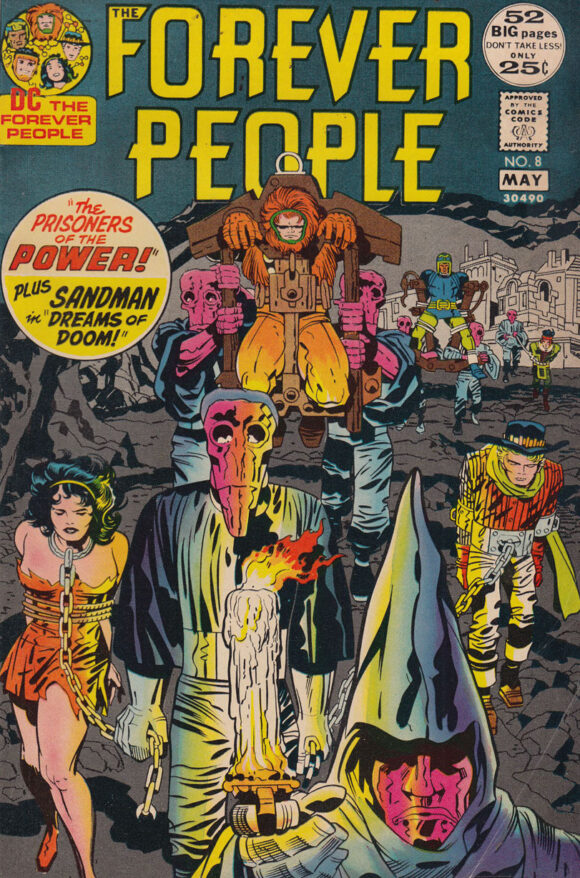
—
8. New Gods #5: Spawn. A lot of New Gods just open on Metron wandering in his chair through the cosmos — in this one he happens by the Source Barrier (I don’t think it becomes a Wall until Dark Phoenix shows up) in just a total throwaway bit until we cut back to Earth, where Orion is in a brutal throwdown with Slig, a member of Darkseid’s aquatic death squad, the Deep Six. Though some people will choose the Metropolis-destroying fight with Kalibak in “The Death Wish of the Terrible Turpin” as the best Orion fight in the series, I’m going with this one instead. Slig can mutate other living things into monsters just by touch, except, of course Orion is already a monster — on the inside. He’s an inverse of Ben Grimm, an antihero whose Greek god good-looks are the put-on, masking the spawn of Apokolips within.
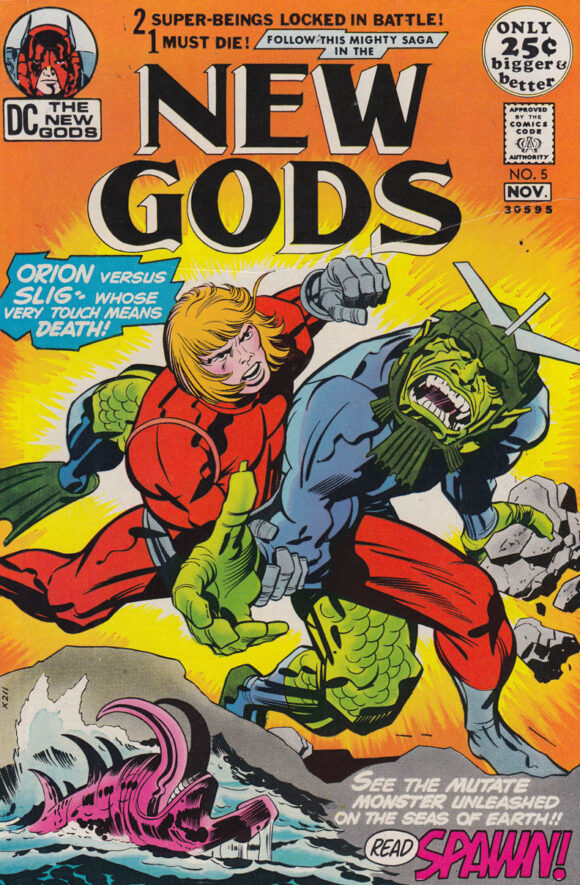
—
7. Mister Miracle #6: Funky Flashman! An anecdote for you: As some of you may know, my wife Crystal Skillman and I wrote a play about the life of Jack Kirby, and in addition to listening to the audio version for free you can now license it and put it on yourself thanks to our friends at Uproar Theatrics.
Our initial showing was in 2014 and we got a glowing New York Times review, which in turn got us a meeting with a hot up-and-coming Broadway director about moving it to a larger venue. During our dinner with him he said he had one note for us:
“Do a lot more with Stan Lee. He’s a really compelling character.”
My head just about exploded.
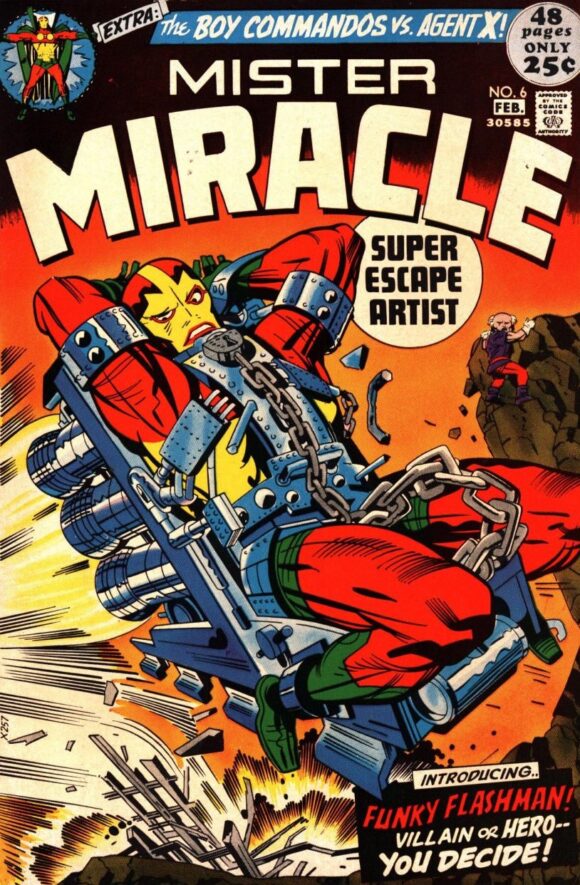
This director was a person who had read (but not seen) the play, and knew nothing about comics. And in a play we wrote about Jack Kirby, it was Stan Lee—the version we wrote—that overshadowed the main character, in his eyes.
I bring this up in the context of “Funky Flashman” because Kirby himself ran into the same problem we did: The persona Stan Lee had come up for himself is so compelling and charming that it sucks in all the nearby attention in its direction.
Even though Kirby’s faux-Stan Lee, the titular Flashman, is a cowardly, backstabbing snake who does his best to cheat everyone he comes into contact with, from Mister Miracle to the Female Furies (who make their spectacular first appearance in this issue) on down to his manservant Houseroy (a.k.a. Lee right-hand man Roy Thomas), he is terrific fun to be around and steals the entire issue like it was a comic book universe.
—
6. Superman’s Pal Jimmy Olsen #143: Genocide Spray! Supes and Jimmy discover some maniac affiliated with the DNA Project has created a miniature planet and bombarded it with old horror movies so its genetically flexible inhabitants take the forms of vampires, werewolves and Frankenstein’s monsters. This dingbat has also programmed a flying demon dog robot to spray the inhabitants with the titular gas to wipe their forms and send them back to the miniature coffin ships. Superman and Jimmy take pity on these Silly-Putty people and re-program their structures by screening Oklahoma! for them instead.
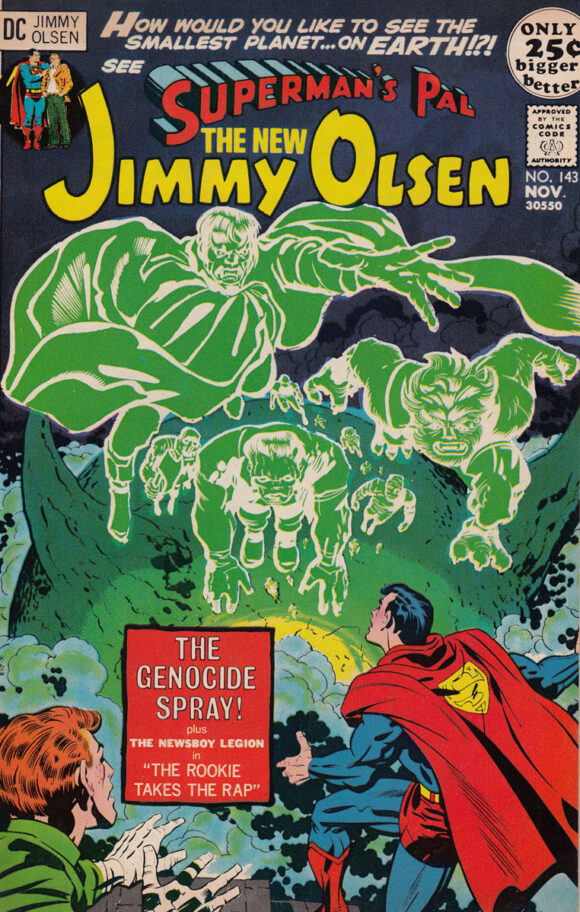
No, I made none of that up. Yes, it is completely awesome.
—
5. Mister Miracle #8: The Battle of the Id! Scott Free voluntarily returns to Apokolips to submit to a trial by combat to win his freedom from Granny Goodness. Mr. Miracle is strapped in a coma next to The Lump, a psychic horror capable of controlling his own dreamscape. Most of the rest of the villains who have plagued him throughout the series arrive to watch — including a surprise appearance by Orion’s mother, Tigra. Meanwhile, Big Barda shows up to retake command of the Female Furies force to lead them on a raid of Granny’s orphanage, basically just for the heck of it. No honor among Darkseid’s minions, apparently. A terrific extra-sized done-in-one, and the way Mr. Miracle prevails is exceptionally clever. The high point of this series.
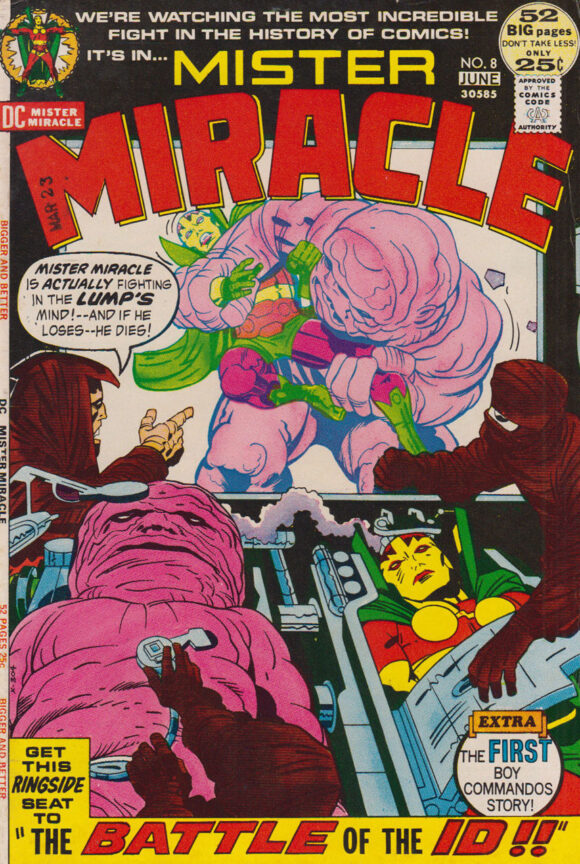
—
4. Forever People #4: The Kingdom of the Damned! Kirby may be known for bombast and cosmic philosophy, but this issue shows off his darker side. Sure, we’ve seen amusement park-as-torture chamber before, but rarely have we seen it so well thought out, with such chilling sadism. The Forever People are sadistic playthings in the hands of DeSaad, where their screams are turned to shrieks of joy for the unsuspecting human guests. Particularly gruesome is the torment of soft-hearted Serafin, who has to vigilantly punch a lever to prevent Vykin from being decapitated by a roller coaster.
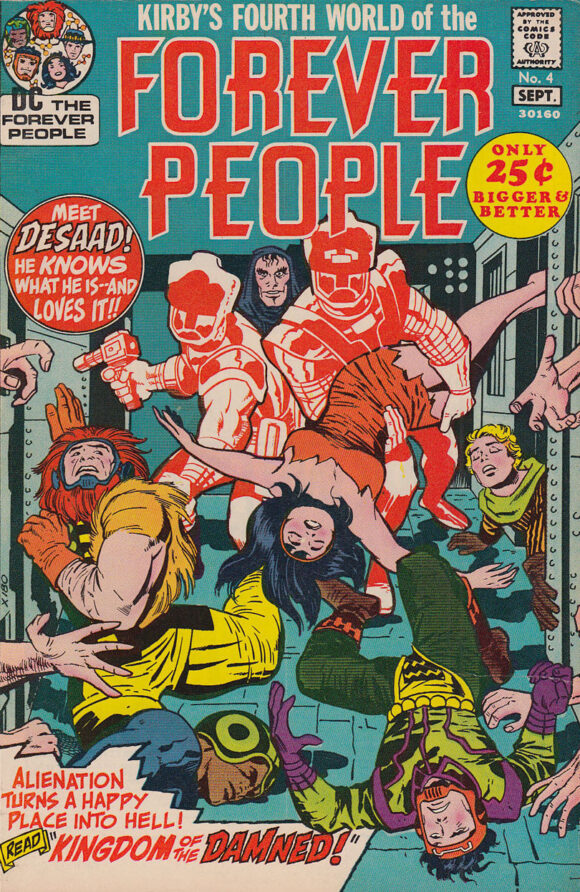
Once again, Darkseid proves the series’ most compelling character as he strides among the unsuspecting guests, laughing at the children who are the only ones who recognize him for what he truly is. Kirby, oft-mocked for his exclamation point-laden dialogue, is, if anything, too cerebral in his Fourth World work, as opposed to the grounded soap opera of his Marvel collaborations with Lee. It’s probably why, as I get older, I reread the Fourth World stuff constantly, even with all their flaws, while the ’60s Marvels feel like kids’ stuff to me.
—
3. New Gods #6: The Glory Boat!! The focus of this justly lauded story has long been on the shipwrecked family who gets caught in the crossfire between Orion and Lightray’s showdown with Darkseid’s Deep Six. Though anyone who’s seen enough 1960s/1970s TV knows how the B-Plot will play out: The blowhard businessman who has contempt for his pacifist son learns the hard way which one of them is really braver.
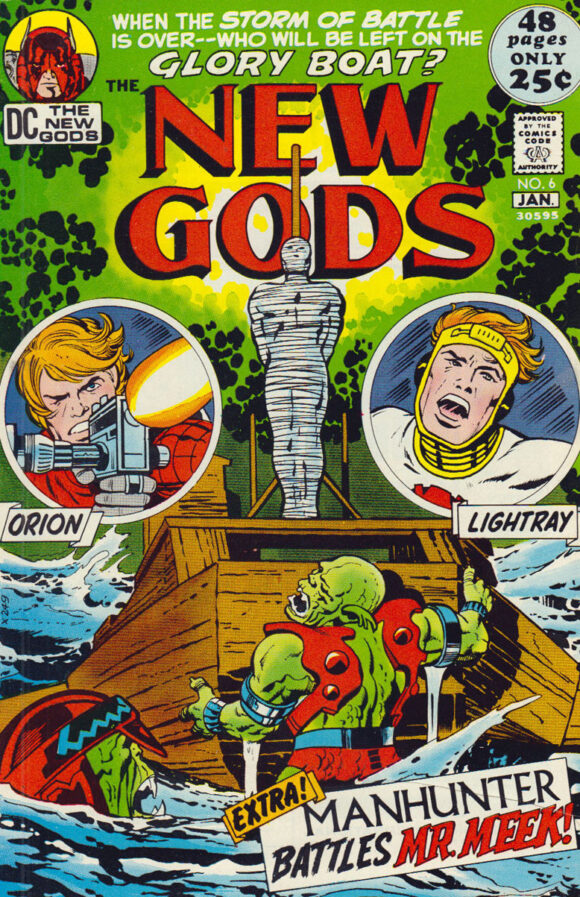
What blows me away is the sheer cleverness of the sci-fi gadget of the title—a boat that contains the “brain” of a destructive sea creature, which Lightray manipulates to evolve, first, into a homing beacon to summon the enemy leviathan, then into a giant torpedo that seals the monster’s doom.
—
2. New Gods #11: Darkseid and Sons! Though most (including Kirby himself) prefer “Death Song of the Terrible Turpin” as the best of the big showdowns between Kalibak and Orion, this is my personal favorite. There are so many terrific character bits: Once Kalibak frees himself from Metropolis Jail and rushes to the house where Lightray and Orion are holed up, Lightray just sits on the couch and says there’s no reason not to just hang out and wait for him.
Here we learn, unequivocally, that Darkseid, this guy fucks — Orion was sired by the woman Queen Heggra wanted his son to wed, Kalibak by his beloved mistress. Heggra had DeSaad poison Darkseid’s mistress, then Darkseid repaid the favor by poisoning dear old Mom himself. I love this stuff!
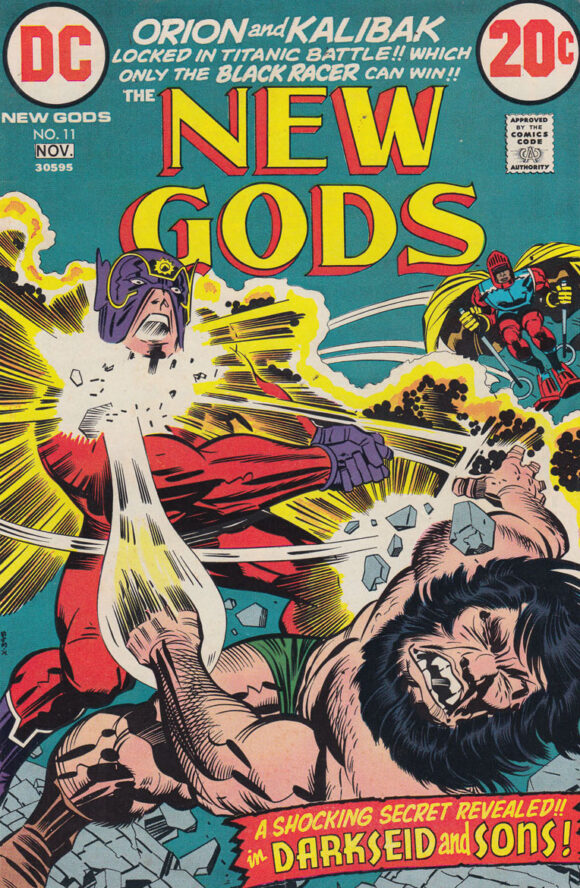
Kalibak develops dangerous new powers for some reason, but Darkseid, seeing Orion as the son truer to his own heart, removes them at the last second, a go-to move stolen from the Old Gods, as Odin used to do this to Thor whenever his son disappointed him (which was constantly). He then catches DeSaad sucking down the bad vibes from the Earth battle like it was lines of coke off a glass coffee table in the ’80s which is too weird even for him, and gives his torturer a dose of the ol’ Omega Beams.
This is the last issue of New Gods, and it goes out with a bang, showing Darkseid for what an incredibly complex character he is beyond the “God of Evil” that lesser talents would try to cast him as.
—
1. New Gods #7: The Pact! In his commentary in the Fourth World Omnibus, Dean Emeritus of Kirbyologists (and Kirby’s assistant during this period) Mark Evanier mentions that Jack, who it may not surprise you was not a person inclined to look backward, mused at one point that he made a mistake by delaying the reveal of Orion’s and Mister Miracle’s shared heritage until this far into the franchise’s run, and I’d say he was on to something.
“The Pact” is one of the great superhero origin stories of all time, and on this re-read I realized that I had an advantage over people who bought the Fourth World books fresh off the rack: Namely, I already knew Orion was Darkseid’s son raised on New Genesis; I knew Mister Miracle is Highfather’s son banished to Granny Goodness’ tender mercies on Apokilips. To not bother bringing this up until almost a year into the Fourth World’s run seems, as they say in journalism, to be burying the lede.
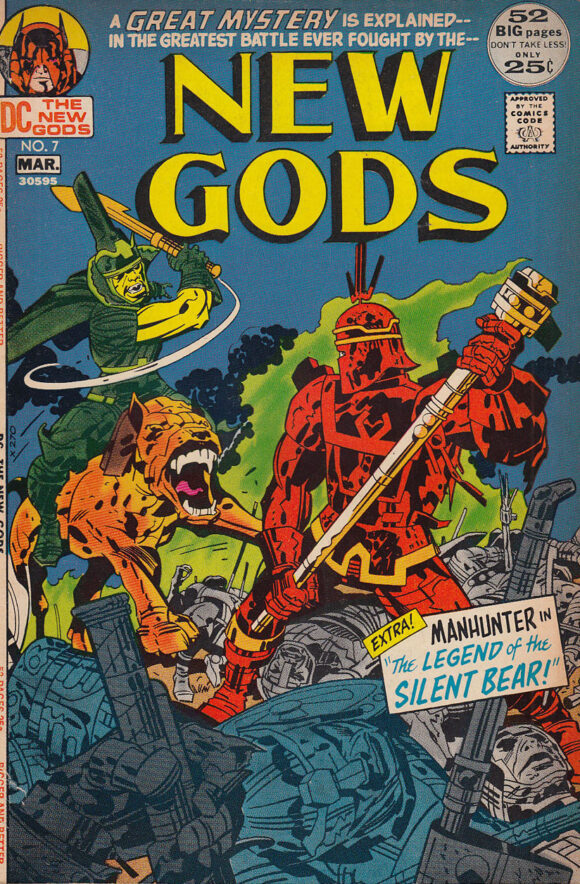
I teach comics writing (and can teach it to you, via video, if you want), and I generally encourage my students to start, you know, at the beginning of their stories, to avoid the very problems Kirby kept running into in the Fourth World. Going from the “One Day The Old Gods Died” prologue in New Gods #1 right into “The Pact” would have given us so much more resonance to Scott Free and Orion’s stories from the start.
The Forever People would come across less as simpering space hippies if we saw the culture that they were rebelling against: “Death to the power of Apokolips!” cry Highfather’s fanatics as they drop an apocalyptic bomb (pun intended) on the planet. “Where its power is created—there it must be smothered and snuffed out!” The Forever People are reacting against the warmongering of older generations, just like the flower children of Kirby’s day; everyone on New Genesis didn’t just wake up one morning pure and good cosmic pacifists.
While I get the desire to introduce, say, Darkseid as a Big Bad from the jump and not being pushed around by Uncle Steppenwolf at the dinner table like he is in this story, treating the Fourth World as a Game of Thrones-style family power struggle from the very beginning would have helped the franchise a lot.
Hindsight being 20/20, I think Kirby maybe should have listened to Julie Andrews and realized that starting at the very beginning is a very good place to start.
—
MORE
— The TOP 13 Issues of JACK KIRBY’s 1970s Return to MARVEL — RANKED. Click here.
— JACK KIRBY AT DC: The TOP 13 Post-Fourth World Stories – RANKED. Click here.
—
13th Dimension contributor Fred Van Lente is a comics writer, historian and playwright.

August 28, 2022
Wishing the late Mr. Kirby a happy birthday!
August 28, 2022
The Forever People reflected the generation gap more effectively than O’Neil/Adams’ Green Lantern/Green Arrow run, did, because Kirby’s protagonists were age-appropriate — had DC used the Teen Titans book to explore why young people were protesting the Vietnam War; for example; more ground could have been covered. But it remains a measure of Kirby’s talent that he captured this convulsive cultural divide more effectively in a superhero comic format than did creators 20 years his junior. If Funky Flashman had given Kirby his fair due, then we never would have had Kirby’s Fourth World, which gave us a superhero platform where Earth is used to export decisive battles: many have tried, but Kirby was first and remains the best at expanding comic book boundaries. The Fourth World is operatic in scale — its prologues alone remain breathtaking, Big Barda’s outfit evolves throughout the series, Kirby’s Superman is thrown-into a conflict where he is not the most powerful but who emerges as the most humane. Kirby’s Fourth World is the gift that keeps on giving 😀
August 29, 2022
“I’ve long thought that an entire series based on the “Young Scott Free” stories was easy money for DC.”
I think that this is the dirty little secret that no one talks about in regard to the Fourth World stories: The backstory is infinitely more interesting than the present day main stories. All of the palace intrigue about how Darkseid manipulated events on Apokalips and New Genesis in order to usurp the throne from his own mother and betray his own uncle; The exchange of children between Darkseid and Highfather; The inner workings of Granny Goodness’ orphanage and Scott Free’s escape. I wish that THAT had been the focus of the Fourth World books. The actual focus on Orion and Lightray, the Forever People, and Mister Miracle coming to Earth and having generic adventures was always mundane and pedantic to me. And it has always surprised me that in the 50 or so years since, DC has never done a full-on, epic, chronological retelling of those mythological New Gods stories. Even when Byrne and Simonson did their runs in the late 1990s and early 2000s, and they filled in more of the backstory, it was still relegated to flashbacks in the back-up stories.